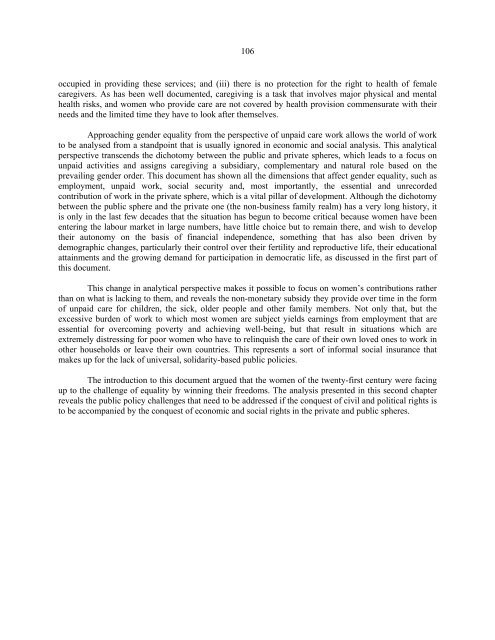Women in Latin America and the Caribbean - Cepal
Women in Latin America and the Caribbean - Cepal
Women in Latin America and the Caribbean - Cepal
Create successful ePaper yourself
Turn your PDF publications into a flip-book with our unique Google optimized e-Paper software.
106<br />
occupied <strong>in</strong> provid<strong>in</strong>g <strong>the</strong>se services; <strong>and</strong> (iii) <strong>the</strong>re is no protection for <strong>the</strong> right to health of female<br />
caregivers. As has been well documented, caregiv<strong>in</strong>g is a task that <strong>in</strong>volves major physical <strong>and</strong> mental<br />
health risks, <strong>and</strong> women who provide care are not covered by health provision commensurate with <strong>the</strong>ir<br />
needs <strong>and</strong> <strong>the</strong> limited time <strong>the</strong>y have to look after <strong>the</strong>mselves.<br />
Approach<strong>in</strong>g gender equality from <strong>the</strong> perspective of unpaid care work allows <strong>the</strong> world of work<br />
to be analysed from a st<strong>and</strong>po<strong>in</strong>t that is usually ignored <strong>in</strong> economic <strong>and</strong> social analysis. This analytical<br />
perspective transcends <strong>the</strong> dichotomy between <strong>the</strong> public <strong>and</strong> private spheres, which leads to a focus on<br />
unpaid activities <strong>and</strong> assigns caregiv<strong>in</strong>g a subsidiary, complementary <strong>and</strong> natural role based on <strong>the</strong><br />
prevail<strong>in</strong>g gender order. This document has shown all <strong>the</strong> dimensions that affect gender equality, such as<br />
employment, unpaid work, social security <strong>and</strong>, most importantly, <strong>the</strong> essential <strong>and</strong> unrecorded<br />
contribution of work <strong>in</strong> <strong>the</strong> private sphere, which is a vital pillar of development. Although <strong>the</strong> dichotomy<br />
between <strong>the</strong> public sphere <strong>and</strong> <strong>the</strong> private one (<strong>the</strong> non-bus<strong>in</strong>ess family realm) has a very long history, it<br />
is only <strong>in</strong> <strong>the</strong> last few decades that <strong>the</strong> situation has begun to become critical because women have been<br />
enter<strong>in</strong>g <strong>the</strong> labour market <strong>in</strong> large numbers, have little choice but to rema<strong>in</strong> <strong>the</strong>re, <strong>and</strong> wish to develop<br />
<strong>the</strong>ir autonomy on <strong>the</strong> basis of f<strong>in</strong>ancial <strong>in</strong>dependence, someth<strong>in</strong>g that has also been driven by<br />
demographic changes, particularly <strong>the</strong>ir control over <strong>the</strong>ir fertility <strong>and</strong> reproductive life, <strong>the</strong>ir educational<br />
atta<strong>in</strong>ments <strong>and</strong> <strong>the</strong> grow<strong>in</strong>g dem<strong>and</strong> for participation <strong>in</strong> democratic life, as discussed <strong>in</strong> <strong>the</strong> first part of<br />
this document.<br />
This change <strong>in</strong> analytical perspective makes it possible to focus on women’s contributions ra<strong>the</strong>r<br />
than on what is lack<strong>in</strong>g to <strong>the</strong>m, <strong>and</strong> reveals <strong>the</strong> non-monetary subsidy <strong>the</strong>y provide over time <strong>in</strong> <strong>the</strong> form<br />
of unpaid care for children, <strong>the</strong> sick, older people <strong>and</strong> o<strong>the</strong>r family members. Not only that, but <strong>the</strong><br />
excessive burden of work to which most women are subject yields earn<strong>in</strong>gs from employment that are<br />
essential for overcom<strong>in</strong>g poverty <strong>and</strong> achiev<strong>in</strong>g well-be<strong>in</strong>g, but that result <strong>in</strong> situations which are<br />
extremely distress<strong>in</strong>g for poor women who have to rel<strong>in</strong>quish <strong>the</strong> care of <strong>the</strong>ir own loved ones to work <strong>in</strong><br />
o<strong>the</strong>r households or leave <strong>the</strong>ir own countries. This represents a sort of <strong>in</strong>formal social <strong>in</strong>surance that<br />
makes up for <strong>the</strong> lack of universal, solidarity-based public policies.<br />
The <strong>in</strong>troduction to this document argued that <strong>the</strong> women of <strong>the</strong> twenty-first century were fac<strong>in</strong>g<br />
up to <strong>the</strong> challenge of equality by w<strong>in</strong>n<strong>in</strong>g <strong>the</strong>ir freedoms. The analysis presented <strong>in</strong> this second chapter<br />
reveals <strong>the</strong> public policy challenges that need to be addressed if <strong>the</strong> conquest of civil <strong>and</strong> political rights is<br />
to be accompanied by <strong>the</strong> conquest of economic <strong>and</strong> social rights <strong>in</strong> <strong>the</strong> private <strong>and</strong> public spheres.











